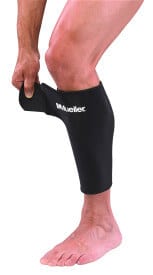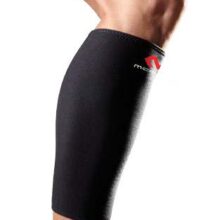Adjustable Calf/Shin Splint Support
Login For Health Care Pricing
Typically Ships in 1-2 weeks
The Mueller Sports Medicine Adjustable Calf/Shin Splint Support features a wraparound design for easy application and removal.

A calf strain is an injury caused by damage to the muscles at the back of the lower leg. The majority of these injuries are minor tears to some of these muscle fibers. However, some calf strains can be so severe as to represent complete tearing (severing) of the calf muscles. When this happens, the affected individual will lose all or most of the function of the leg. Walking, running or even just standing up will become difficult or impossible.
Most calf strains involve damage just above the halfway point between the knee and ankle. The typical first sign of this injury is a sudden, sharp pain in this area. That pain will continue and will eventually be accompanied by tenderness and swelling of the calf area.
The appropriate treatment for mild calf strains includes resting the leg as well as applying ice. However, for the occasional severe calf strain, conservative home care may not be adequate and surgery may be indicated.
Calf strains are most commonly observed in men between the ages of 30 and 50.
The calf muscles of the lower leg run all the way down starting from the knee and connecting to the Achilles tendon just above the heel. The calf plays a key role in several athletic activities, including high speed or long distance running and bearing heavy weights. These activities demand both explosive power and endurance from the calf muscles and make calf strains more likely.
There are actually two major muscles in the calf area – the gastrocnemius and the soleus. The gastrocnemius muscle has two heads. There is one on the medial or inner side of the knee and another on the lateral or outer side.
Either of these muscles can be damaged if one suffers a calf strain. However, the most common area of injury is the medial (inner) head of the gastrocnemius. The gastrocnemius is a biarthrodial muscle that extends over two joints – the knee and the ankle. Because of this, it tends to experience higher forces and is more vulnerable to overstretching or tearing (i.e. a strain).
The soleus muscle crosses only one joint (the ankle) and is therefore less vulnerable to strains. However, it should be noted that soleus strains do happen, albeit rarely.
As with most types of soft tissue injuries, doctors classify calf strains into 3 grades. We describe the extant of muscle damage and the accompanying symptoms below::
This is the mildest injury category. The calf muscle damage involves overstretching of the calf muscle but no tearing.
The patient experiences a sharp pain in the calf area at the time the injury occurs and may experience “tightness” afterwards. However, he or she may still be able to continue physical activity with mild discomfort at most.
This injury is referred to as a mild strain or “pull” of the calf muscle”.
This involves partial, but not complete, tearing of the calf muscle.
The patient will again feel a sharp pain in the calf at the time of injury and will be unable to continue physical activity. He or she will experience significant pain even from just walking. There may also be swelling in the calf area as well as mild to moderate contusions.
With this grade of calf strain, the patient will have suffered a complete tear (rupture) of one or more calf muscles.
There will be severe pain at the time the injury is incurred. It will most likely be felt at the point where the muscle meets the tendon, as that is where the rupturing frequently takes place. The injured individual will have to cease activities immediately. He or she will likely notice significant bruising and swelling in the calf area within hours of the onset of the injury.
Individuals experiencing these symptoms should contact a doctor (preferably one with a sports medicine background) for medical advice.
Diagnosing this injury is usually a straightforward process. However, the doctor will have to eliminate other causes of calf pain before concluding that a calf strain has occurred. Other possible causes of calf pain include a baker’s cyst, leg craps and blood clotting.
It is also important for the doctor to identify severe calf strains in which the muscle has been ruptured. In some (but not all) of these cases, it may be necessary to perform surgery to correct the damage.
In general, the appropriate treatment of a calf strain depends on the severity of the strain. Almost all mild (grade I) or moderate (grade II) strains can be successfully treated by a P.R.I.C.E. protocol as described below.
Some of the strains in the most severe (grade III) category may require surgical intervention.
The patient must be careful to Protect the calf by avoiding activities that could further aggravate his or her calf muscles. This may require keeping all body weight off the injured calf. To do this, the patient may be asked to consider using crutches or even a wheelchair.
The key to treating most grade I or II calf strains is to allow the injured muscle to Rest and recover naturally. Any activities that cause calf pain should be put on hold for the time being. The rest period should continue until the patient is once again pain free.
In addition to rest, the patient may be advised to do the following :
A vital part of the treatment process will be undergoing physical therapy. The therapist will devise an exercise program to stretch and strengthen the calf muscles as the patient prepares to resume normal activities. This is an important step to reduce the risk of re-injuring the calf muscles at some future date.
Although surgery is sometimes required to treat a calf strain, this is a relatively rare occurrence. Complete rupturing of calf muscles is relatively rare, so non invasive treatments are usually adequate.
As with most injuries, this depends on the severity of the injury. It also depends on the patient’s compliance with recommended treatment. If the patient attempts to recommence normal activities prematurely, this could set back the healing process. The recovery period will then be longer as a result.
Having said this, for a grade I strain, most patients will be ready to resume normal activities in 7-10 days. However, for a grade 2 strain, the recovery period can be as long as 4-6 weeks. A grade 3 strain requires as much as 3 months or more before recovery is complete.


Login For Health Care Pricing
Typically Ships in 1-2 weeks
The Mueller Sports Medicine Adjustable Calf/Shin Splint Support features a wraparound design for easy application and removal.

Login For Health Care Pricing
Out of Stock
The LP Support Calf Power Sleeve features a Y shaped Power Band, a Regulation Area and seamless Lycra for unmatched performance and comfort.


Login For Health Care Pricing
In Stock
The LP EmbioZ Calf Power Sleeve with Silicone features a Power Band around the calf muscles that enhances lower extremity kinetic chain movements between the leg ankle. It also prevents overstretching, stabilizes ankle movement, increases proprioception, and enhances the effectiveness of leg movement reproduction.

Login For Health Care Pricing
Typically Ships in 3-5 Business Days
The McDavid Calf Sleeve offers contoured, pull-on, latex-free thermal/compression therapy and soft tissue support.
Level 1: Primary Protection – Reducing pain associated with calf strains, shin splints and varicose veins; aids recovery

Login For Health Care Pricing
Out of Stock
Thanks to the SkinLok™ feature, a strategically positioned gel pad and its low profile design, the BioSkin Compression Shin Splint will provide you with unsurpassed relief from the pain of shin splits, calf strains and sprains and other injuries of the lower leg. Made in the USA.


Login For Health Care Pricing
Typically Ships in 1-2 weeks
The Incline Board is useful for stretching the upper and lower back as well as calf muscles in order to keep the tissues in these areas warm and supple.


Login For Health Care Pricing
Out of Stock
The LP EmbioZ Leg Support Tights with Silicone features a Power System along the lower body to improve muscle endurance, blood & lymphatic circulation and the overall efficiency of the lower body kinetic chain. Combined with its seamless design, general compression and Comfort System, these tights will take your performance to new levels while you enjoy greater comfort levels during training or competition.